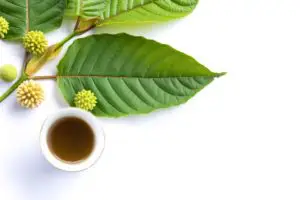Does Kratom Tea Help With Anxiety, Pain, and Opiate Withdrawal?
May 28, 2021
Kratom tea is getting plenty of attention nowadays, but what actually is it? This energizing or relaxing brew (depending on the strain) comes from the leaves of the kratom tree.
This now-famous tree, which is part of the coffee family, originates from Southeast Asia, and remains wildly popular in the region. And with globalization and the emergence of the internet, kratom is now getting big in the Western world too. Kratom is being used for natural pain relief, to soothe anxiety and depression, combat opiate withdrawal symptoms, and even as a natural high.
But given the rapid rise of kratom products, it’s unsurprising they’ve attracted plenty of questions and courted controversy. To some, kratom is dangerous, addictive and even deadly.
The Drug Enforcement Administration (DEA) moved to ban kratom in 2016, but its efforts stalled after a vociferous fightback from the kratom community.

However, negative stories have continued to filter through – in 2018, a lawsuit filed in Florida claimed that kratom tea was responsible for permanent brain damage.
Currently, the Food and Drug Administration (FDA) has not approved and does not regulate kratom products. But the federal agency has sent warnings to multiple companies, instructing them not to make medicinal claims about products that are not backed up by scientific evidence. It’s clear that kratom tea isn’t like a regular tea, and has some pretty potent effects. For that reason, anybody using kratom should do so with caution. However, since millions of people across America are happily taking kratom, they must have some good reasons for doing so! Let’s take a closer look at what kratom tea has to offer.
What’s in kratom tea?
Traditionally, kratom tea was brewed with the leaves, and still is in Southeast Asia. However, since the leaves are less accessible in the Western world, kratom tea here is typically brewed with kratom leaf powder and boiling water.
These leaves are rich in alkaloids, including mitragynine, a compound that interacts with opioid receptors not dissimilarly to codeine and morphine, which are present in opioid painkillers.
But crucially, mitragynine and other kratom alkaloids don’t bind as strongly to these receptors. Kratom powder can also be consumed directly with water, taken in a capsule or paste, or added to recipes.

Kratom advocates claim that tea has analgesic effects, providing opiate-like effects with less of an addictive risk. Kratom tea may also help tackle opiate withdrawal symptoms, and offer relief from depression, anxiety and stress.
Stimulating, white-vein kratom strains are associated with reduced fatigue, improved mood, increased concentration and enhanced sexual performance.
However, despite these bold claims, Maggie Moon, RS, MD, notes that there is “insufficient evidence” to support any of them, hence why the FDA has taken a tough stance toward vendors making health claims about products.
The FDA has stated there are currently “no adequate and well-controlled scientific studies” assessing kratom’s benefits for opioid use withdrawal and other conditions. Furthermore, we’ve no evidence on how kratom interacts with other drugs, nor do we have a clear understanding of kratom’s side effects and dangers.
This is understandable given kratom is relatively new to the West, but it hammers home the need for users to be careful.
Exploring kratom tea’s risks
Studies show that regular doses of kratom may cause a range of side effects, such as nausea and vomiting, dizziness, drowsiness, dry mouth, reduced appetite, rapid heart rate and a loss of muscle coordination. Larger kratom doses have been linked to more serious health problems, including seizures, slowed breathing, heart rate changes, comas and even death.
The Pharmacotherapy journal published a study in 2019, analyzing data from the National Poison Data System, collected from poison control centers across the country. They revealed that more than 2,300 people had contacted centers about kratom use, and highlighted the most common symptoms reported by callers.
Agitation (18.6%), a rapid heartbeat (16.9%) and drowsiness (13.6%) were the most common symptoms reported. Serious symptoms were also noted – seizures (6.1%), hallucinations (4.8%) and coma (2.8%). This indicates kratom may cause a multitude of side effects, but without data on dosages taken, it’s difficult to paint a clear picture. Moreover, these percentages describe symptoms experienced by people who contacted poison control centers, and are not reflective of all kratom users.
That considered, the most serious side effects are unsurprisingly linked to higher kratom dosages. Recreational users tend to take the drug in larger amounts for the euphoric high, which is particularly prominent in red-vein kratoms. As of February 2018, the FDA notes that 44 deaths have been connected to kratom products. It’s possible that low-quality kratom products, potentially mixed with other ingredients, are increasing the risk to users. It appears that kratom risks increase when consumed with other drugs. The FDA has found that kratom mixed with hydrocodone and other opioids increases the risk of liver damage and withdrawal symptoms. The FDA suggests kratom use could potentially cause brain damage (in reference to the aforementioned 2018 lawsuit), however there is not enough research to say this with certainty.
Kratom’s legal status in the US
Per the federal government, kratom is legal in the United States as of April 2020. However, kratom is banned in Alabama, Arkansas, Indiana, Rhode Island, Vermont and Wisconsin. A handful of counties and cities have also prohibited kratom products. Due to the FDA not regulating the industry, there is a high risk of impurities in products. The best kratom vendors get products tested by third-party laboratories, to distinguish themselves from the rest of the market.

Kratom supplements are not always marketed as “kratom”. Other names regularly used to describe products include: Biak-Biak, Ithang, Kedemba, Madat, Maeng Da Leaf, Mitragynine Extract and Thom. With our current understanding of kratom, users should exercise caution if taking products, and do their research to ensure they are buying from reputable vendors. If uncertain about using kratom products, consult with a medical professional. Moreover, check that kratom is legal in your jurisdiction before purchasing, or your product may not arrive.